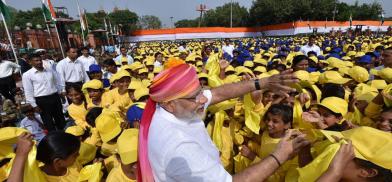Is India’s populist surge a threat to liberal democracy?
The success of Modi’s populist campaigns in 2014 and 2019 Lok Sabha elections, followed by the majoritarian mobilizations and lurking use of repression, pose a serious threat to liberal democracy in India, writes L T Om Prakash for South Asia Monitor

The Bharatiya Janata Party (BJP) has been projecting Prime Minister Narendra Modi as a charismatic leader capable of transforming India into a superpower. Modi, in his turn, captured the national attention through systematic use of his public relations and event management skills. His moralistic self-assertions and attempts to brand the opposition as “corrupt, dynastic elite” to weaken the opposition’s moral appeal and to present himself as the only savior of the country resembles the core features of a populist leader.
A glance into the functioning of populists like Alberto Fujimori in Peru, Hugo Chavez in Venezuela, Rafael Correa in Ecuador, Evo Morales in Bolivia, Recep Tayyip Erdogan in Turkey and DonaldTrump in the United States of America at various times resemble Modi’s functioning. One common similarity is that all of them pursued large-scale changes in the constitutions of their countries and attempted to consolidate power at their hands through the systematic destruction of established institutions and articulated anti-elite, nationalist rhetoric to generate support through contentious visible political actions.
Gaining power through popularity and appealing people with the purported charisma, charm and identity is a defining feature of a populist leader. The 2014 and 2019 Lok Sabha elections in India are known for presidential-style campaigns by the BJP projecting Modi as a leader of impeccable character. For the 2014 elections, most part of the BJP party manifesto is modeled on the 5T vision (technology, talent, trade, tourism and tradition) of Modi. He used the “chaiwala” (tea seller) remark by Mani Shankar Aiyar from the opposition Congress Party in his favour to identify himself with the poor and to kindle the voter sentiments. In a similar vein, for the 2019 elections, Modi countered the “Chowkidar Chor Hai” (the watchman is a thief) remark by Rahul Gandhi with “Main Bhi Cowkidar” (I am a watchman too) campaign centering himself. Any personal criticism on Modi was dealt sternly by the party. The BJP used populist tropes of ‘corrupt dynastic elitism’, ‘anti-majoritarianism’ and ‘leadership inefficiency’ to negatively characterize the Congress and other opposition parties in both the elections.
Populists prefer mass meetings of direct communication with the people aiming at moralistic self-recognition for power consolidation. Modi, for his turn, is keen to maintain direct contact with the people and has effectively used the digital media to capitalize on the parochial sentiments of people. The popular enthusiasm for Modi is amplified by the media. He has become a simulacrum, a media artifact regarded as truer than any amount of information. The more people believe in him, the more media could recreate his ‘pure’ and ‘efficient’ image resulting in a vicious cycle.
Populists lack trust in the mainstream media. Populists of the time – Trump is a prime example – are also known for their early adoption of social media platforms for the reason that it provides personalized, quick, and convenient direct contact with the followers, circumnavigating the cumbersome established protocols of mass communication. Modi and the BJP too adopted the same mode and style of communicating with the people. Modi’s extensive use of social media is his deliberate strategy to overcome the democratic constraints of mainstream media on populism and to brand himself as a tech-savvy, new-generation leader capable of transforming India. His frequent rallies and Mann Ki Baat radio talk are also the expressions of populist mindset aimed at directly communicating with the people.
Strong subnational leaders and parties are a deterrent to the populist leaders to directly influence the voters. Regional and sub-national identities played a pivotal role in the emergence of influential regional political parties in Tamil Nadu, West Bengal and the Northeast. In fact, such strong sub-national identities of the south and north-east stood as bulwarks against the BJP’s nationalist-populist strategy. Charisma of a populist leader will be of appeal to the masses only if such sub-national identities are mitigated by polarizing people on other grounds by fragmenting the existing system. In this sense, Citizenship Amendment Act (CAA) is another populist strategy of BJP to find inroads into the South and Northeast by polarizing and fragmenting people on religious lines, whereas the regional parties are based at linguistic and subnational identities.
Populists would aggravate and resolve erstwhile dormant social and political issues using the logic of division. For the personal and political benefits, populists press for more systemic ‘solutions’, like changes in the constitution, to resolve the aggravated issues by aggregating the demands from different quarters of the society. This leads to out of the way revolutionary decision making a hallmark of populist governance. Jammu and Kashmir Reorganization Act, CAA and Demonetization are the testimonies of this trend from the present regime. Nevertheless, the BJP in its election campaigns proclaimed “one nation, one people and one culture” – a populist-normative agenda. In a pluralistic country like India, implicit in this agenda is the anti-democratic process of identifying the ‘other’ category of people and excluding them for homogeneity – to create a nation of one people with one culture.
Populism is intolerant in its very essence. In a multiparty liberal democratic system like India, the most sustained form of opposition can be from the opposition political parties. Evidences worldwide suggest that the populists identify the opposition parties with the supporters of corrupt elite and ‘the other’ people in order to debunk opposition disagreements. Besides, the Modi regime has been promoting faith over reason as evidence to defend itself against the accusations of opposition parties. Nevertheless, the state agencies are been used to brand the opposition as corrupt and to destroy their moral stature to rescind the public appeal of dissent from the opposition.
Populism impacts democracy as the former anchors its political legitimacy on the nebulous idea of popular, majoritarian sovereignty that contrast with the democratic-republican ideals. To mobilize support and to sustain legitimacy, populists have to identify ‘the other’ category of people against whom they can muster support. Vilifying the old political order as corrupt and inconsiderate to the masses, and undermining the foundations of established institutions that stand against populist gratifications are the well-known populist tendencies which the present Modi regime represent.
The success of Modi’s populist campaigns in 2014 and 2019 Lok Sabha elections. followed by the majoritarian mobilizations and lurking use of repression, pose a serious threat to liberal democracy in India. Although populism is historically located between fascism and liberalism, the present Modi regime has been constantly using the rudiments of fascism to challenge liberalism. This populist regime is capable of corroding the democratic spirit of people and their faith in democracy, if in power for a long time. Fascism is the natural outcome of populism as it undermines the checks and balances of a democratic system. Therefore, the populist tendency of the present regime is a danger to democracy in India. Looking at the grooming and temperament of the leadership, one cannot expect the BJP to depart from its populist strategy soon.
(The writer is Associate Professor of Sociology at CHRIST, Deemed to be University, Bengaluru. The views expressed are personal)














Post a Comment